The historical landmarks in Bengaluru reflect Tipu's innovation and experimentation.
Published Mar 02, 2025 | 7:00 AM ⚊ Updated Mar 02, 2025 | 7:00 AM
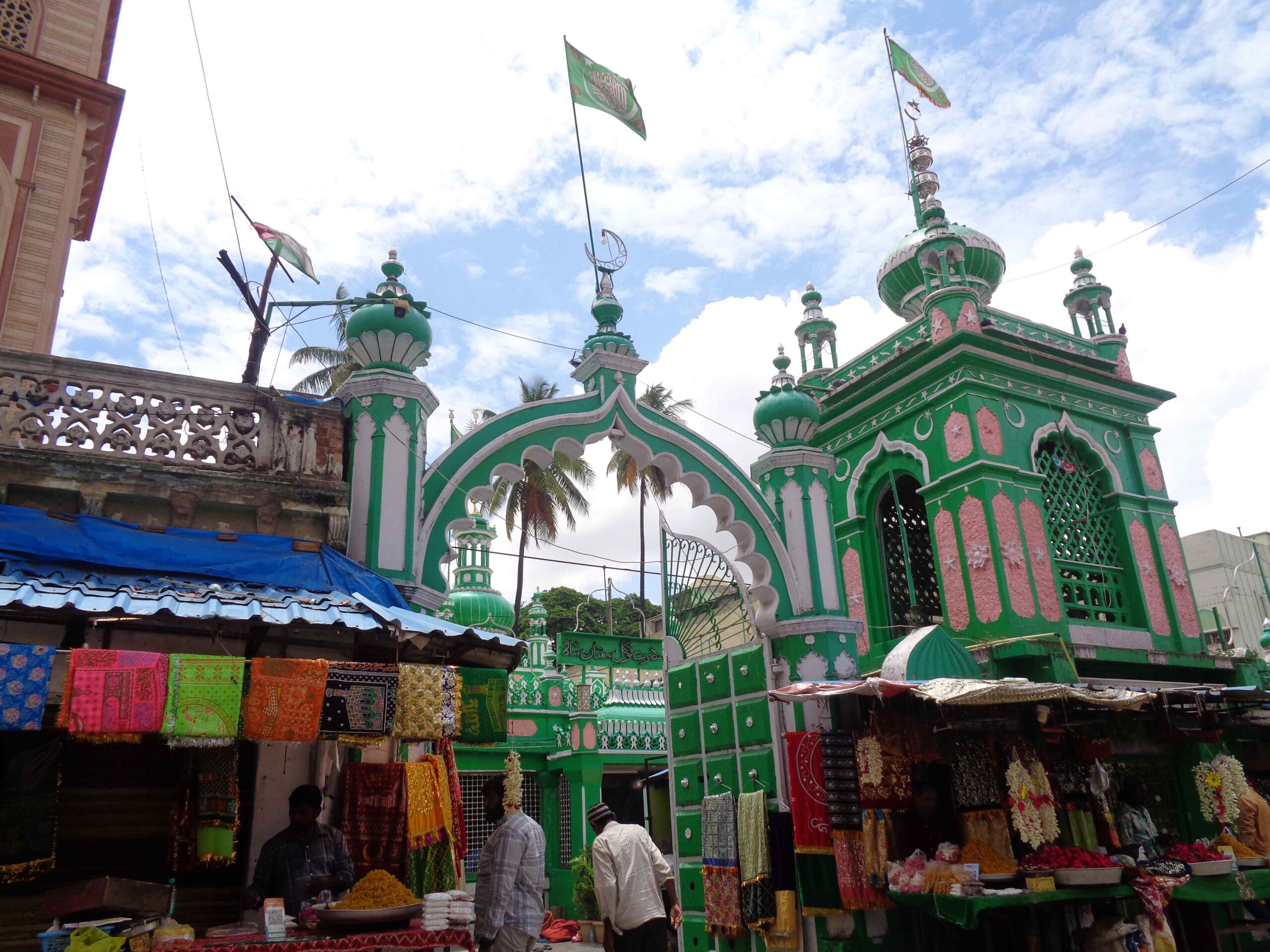
Hazrat Tawakkal Mastan Dargah. (Anuradha Prasad)
Synopsis: Tipu Sultan, who hit the pause button on British ambitions for a while, still lives on despite the onslaught of time and political controversies that often erupt over him
Eighteenth-century ruler Tipu Sultan, a complex historical figure, is still news.
His legacies live on in Bengaluru, albeit in fragmentary form and under the shadow of the political climate and conflicting versions of a ruler who was as hated as he was admired. While his military might may be well-regarded, he also unleashed terror on certain communities.
Born as Fateh Ali Sahab Tipu — later known as the Tiger of Mysore — he was the son of Hyder Ali, a commander in the Wodeyar king’s army. Bangalore (Bengaluru) was given to Hyder as jagir (a feudal land grant ) by the Wodeyar king. However, he deposed the Wodeyar king and took charge of the Mysore (Mysuru) state.
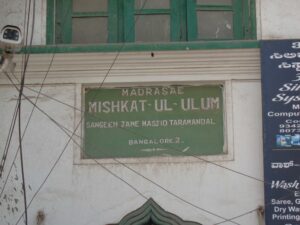
The masjid at Taramandal. (Anuradha Prasad)
Tipu built on his father’s vision, bringing innovation and experimentation to the forefront, which is evident in a few of the historical landmarks that continue to stand. His association with the French emperor, Napolean Bonaparte, is well-documented.
The French influence can be seen in engineering, the most infamous of which is Tipu’s Tiger, a mechanical tiger mauling a British soldier. It is on display at the V&A (Victoria and Albert) Museum in London. The mechanical tiger was seized by the British, who killed Tipu in the Fourth Anglo-Mysore War in 1799.
The Sultan’s legacy, however, still lives on in various monuments scattered in Bengaluru and Mysuru regions.
It is easy to miss the Sangeen Jame Majid in the busy Pete area. It dates back to 1687, when Khasim Khan, a Mughal commander, controlled Bangalore, before it was sold to the Wodeyar king.
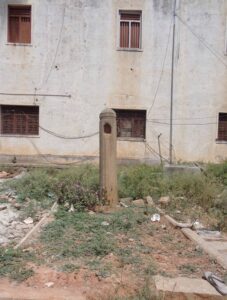
At Taramandalpet, all that remains of the era is a stone pillar over what is believed to be an unmarked grave of a soldier. (Anuradha Prasad)
This makes it one of the oldest mosques in the city though in the 1980s the old mosque was replaced with a new one. A school is located next to it.
It was in the vicinity of this mosque that Tipu’s famous rocket laboratories were located.
While Hyder used rockets, Tipu made them better, pioneering rocket technology in warfare with the Mysorean rockets, an innovation lauded by Abdul Kalam in the Tipu Sultan Shaheed Memorial Lecture and NASA. The laboratories were also present in Chitradurga, Bidanur, and Srirangapatna.
The areas where the rockets were made were called Taramandalpet (star-cluster markets) because of the star-like explosions of the rockets that were tested.
These rockets were iron-cased and included a blade stabilized with a bamboo pole; the British army feared them and called them the “flying plague.” The military manual Fath-ul-mujahideen by Zainul Abedin Shustari outlines Tipu’s strategy: There were 200 rocket men with rocket launchers in every brigade.
The rockets were confiscated by the British after defeating and killing Tipu in 1799. These rockets are the prototype for the famous Congreve rocket that was created in the early 1800s by Sir William Congreve, and they were used in the Battle of Waterloo in which Tipu’s ally Napolean was killed.
One of the rockets is displayed in the museum at Tipu’s Summer Palace.
At Taramandalpet, all that remains of the era is a stone pillar over what is believed to be an unmarked grave of a soldier from Tipu’s army martyred when fighting the British. His name, a bystander says, is Noor Shah Wali.
According to Vijay Thiruvady book’s on Lalbagh, a garden called Kemputhota stood there during Kempegowda’s time.
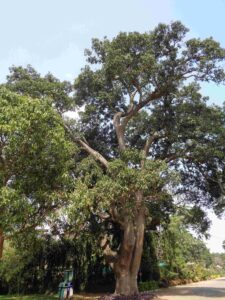
The more than two-century-old mango tree at Lalbagh. (Anuradha Prasad)
Hyder created a Persian-style char bagh there, a pleasure garden with fountains and walkways. The char bagh was located toward the present-day Mavalli gate. Mavalli means “mango village” and was named after the mango orchards in the area.
Tipu envisioned Lalbagh as a center of horticulture. Suresh Jayaram writes in Bangalore’s Lalbagh: A Chronicle of the Garden and the City that Tipu procured seeds and saplings from different parts of the world including the Jardine du Roi and French colonies such as Mauritius.
Known as the Sultan’s Garden and for a time as the Rose and Cypress Garden, it was renamed Lalbagh in the late 1800s.
The British (pre-Independence) and the state administrations have since continued to build on Tipu’s legacy. Only one mango tree, around 250 years old, still stands in Lalbagh from Tipu’s era.
A small portion of the larger Bangalore Fort stands at the entrance of Victoria Hospital.
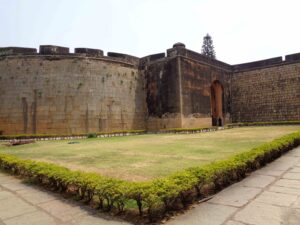
Bangalore Fort. (Anuradha Prasad)
Kempegowda-I had built a mud fort, which was expanded by the Wodeyars. Hyder further fortified the eighteenth-century military fort with stone blocks. A
Ganesha temple is located inside the fort though it is unclear when it was built. The gandabherunda, the royal insignia of the Wodeyars, indicates it was built by the Wodeyars. A local guide, Manjunath, points out that the alcoves are blackened by the torches that were used in that era.
Islamic architectural elements like stucco carvings overlap with French engineering design. In Discovering Bengaluru, Meera Iyer points out the banquettes and embrasure openings on the firing side, which are French influences.
Iyer writes that Tipu may have had the fort dismantled after his defeat in 1791. Eventually, the poorly maintained fort became the fodder that fed new infrastructure. Its stones were even used in building Victoria Hospital.
What remains is the Delhi Gate and two bastions with huge doors of seasoned wood studded with metal spikes to prevent war elephants from smashing it down. A tablet is embedded in the outer fort walls where hawkers sell wares. This is where the British breached the fort during the Third Anglo-Mysore War.
The fort includes the dungeon, inaccessible to the public, where dangerous criminals and prisoners of war were held. The walkway inside the fort leads to it.
One of the prisoners held here for a few years was Captain Baird. He was in the army led by Lord Cornwallis that breached the fort. It was to him that the British presented Tipu’s bedchamber sword after Baird helped identify Tipu’s body in the Fourth Anglo-Mysore War.
It is the same sword that Vijay Mallya purchased at an auction and whose current ownership is unknown.
Another one of Hyder’s projects completed by Tipu is the Summer Palace. It is a two-story Indo-Islamic building, which was part of a larger complex of palaces and buildings, all of which were destroyed by the British. By the palace is the Kote Venkataramana Swamy Temple, dating back to 1690, built by Chikkadevaraja Wodeyar.

Tipu Sultan’s Summer Palace. (Anuradha Prasad)
Both Hyder and Tipu paid their respects at the temple.
The construction was started in 1781 and completed in 1791. The inscription reads: The Abode of Happiness and Envy of Heaven. Made of stone, wood, plaster, and mortar, the building stands on a stone plinth and boasts 160 fluted pillars of teakwood and madder red walls. It has two balconies at the mezzanine level where Tipu held court and on the side are the zenana quarters for the royal women.
The plaque in the Palace also speaks of Tipu’s Register of Dreams and includes a few excerpts from it. A small room on the ground floor is the designated museum area and you can see a miniature version of Tipu’s Tiger and a Mysorean rocket.
The British used this building as their administrative office when they built the cantonment in Bangalore before they moved to the more spacious Public Offices.
The armory is situated close to Tipu’s Summer Palace and the Bangalore Fort. This is where gunpowder, ammunition, and weapons were stored. Considering the risk of accidents, the armory was built partially underground with lime and stone mortar and thick walls to maintain a cooler temperature inside.
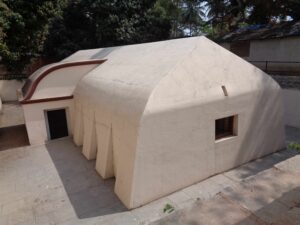
Tipu’s armory. (Anuradha Prasad)
The vaulted ceiling meant that the building would cave in if it exploded. There was a drainage system, too, to let out rainwater. Some accounts claim an underground tunnel linking it to the palace.
This was but one of the 10 armories. At least six were located in Srirangapatna, which was Tipu’s capital. The armory was crucial in warfare and was one of the reasons that led to Tipu’s defeat in the last Anglo-Mysore War.
One of Tipu’s ministers Mir Sadiq betrayed him and this betrayal included withdrawing troops and flooding the armory after plugging the drain, which rendered the stored ammunition useless.
The armory in Bangalore, which was in a bad state, has been restored, but it is not open to the public and can only be seen from outside.
Tipu is believed to be named after a saint called Hazrat Tipu Mastan. He was one of the three saints in whose honor dargahs have been built: Hazrat Tipu Mastan’s dargah is in Arcot, while those of Hazrat Manik Mastan and Hazrat Tawakkal Mastan are in Bangalore’s Pete area.
The three spiritual brothers came to Hyder Ali’s attention when the stone fort was being built because they did not collect wages. On following them the fort killedar (the title for the governor of a fort or large town) Ibrahim Khan reported to Hyder that they disappeared after entering a mosque.
In some accounts, there were human parts that were guarded by dogs. They realized that these men were saints and built a mosque upon their request. Hazrat Tawakkal Mastan’s dargah is the most famous of the three. People come here for healing and the annual karaga (a folk festival, which originated as a ritual dedicated to Draupadi) procession stops here for the saint’s blessings.
Tipu Sultan was the British’s strongest opposition in south India for a long time. Since his death, his progeny and members of his family were exiled to Kolkata. While only traces of his rule remain in Bangalore — now Bengaluru — what remains showcases a controversial ruler over the dust and rubble of history.
(Anuradha Prasad is a Bengaluru-based writer and editor. She runs the Instagram page @knowbangalore, documenting the city’s history and heritage, and freelances as a heritage walking tour lead. Edited by Majnu Babu).
